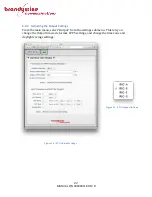
MANUAL P/N 900000118 REV D
9
4
Getting Started
Figure 1 - Portable Timing Unit
4.1
Powering up the PTU
The PTU can be powered from 110Vac via the AC power cable, or from external
12Vdc via the DC power cable. Both cables plug into J11, a 5-pin power connector
on the rear of the unit. The PTU must be turned on for battery charging to
commence. (See Figure 22 - PTU Rear Panel)
A front panel power switch is used to turn the unit on.
4.2
Setting the Network Address
Connect the unit to an Ethernet switch via J10, the Ethernet connector. The PTU
uses a 10BaseT Ethernet interface without Auto-MDIX, so if a connection is to be
made directly to a laptop, a cross-over Ethernet cable must be used.
4.2.1
Discovering the IP Address.
Power the PTU off, and then power it back on. Press and hold the display switch.
The Unit IP address will be shown after approximately 30 seconds.
4.2.2
GPS Operation
When GPS is selected as reference, ensure that a GPS antenna is connected to the
unit. The chassis mounted antenna can be used by simply connecting J1 to J2 with a
short coax cable (provided.) Alternatively, an external antenna can be used by
connecting it directly to J1, the GPS receiver input.
It typically takes approximately five to six minutes for the PTU to complete its
Rubidium warm-up cycle, acquire satellites and start displaying valid time. Until it
does, the PTU will display a simple count value starting from 0. In a cold start
























